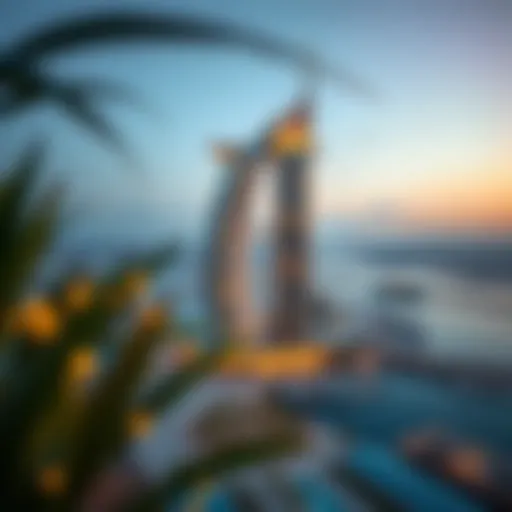Exploring the Architectural Significance of Al Wasl Building
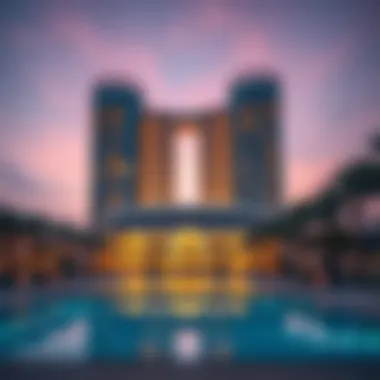

Intro
The Al Wasl Building, a remarkable addition to Dubai's skyline, captures the essence of innovation and architectural brilliance. Standing tall amidst the vibrancy of this bustling city, the structure is not just about its impressive height or exterior design; it embodies a significant narrative within the fabric of Dubai. This article aims to peel back the layers of this architectural masterpiece, serving as both a landmark and a catalyst for change in the urban landscape.
As we delve deeper, we’ll explore its striking design, the historical context that shaped its creation, and its role in the evolving real estate market in Dubai. The Al Wasl Building represents more than just a stunning view; it's a focal point of community engagement and economic opportunity.
Throughout this article, readers will gain insight into the property trends surrounding this notable structure, as well as expert perspectives that will help navigate the complexities of real estate investments in Dubai. Together, we will illuminate how the Al Wasl Building stands not only as a testament to modern architecture but also as a symbol of Dubai's dynamic spirit.
Al Wasl Building: An Overview
The Al Wasl Building serves as a pivotal element in the ever-evolving skyline of Dubai. This structure is not just another glass-clad high-rise; it is a representation of the city’s transition into a hub of global architecture and design innovation. By delving into its historical context, architectural style, and accessibility, one can gain insight into why this building is deemed significant beyond its physical presence.
Historical Significance
The roots of the Al Wasl Building run deep within the tapestry of Dubai’s cultural and historical landscape. Named after a term meaning “connection,” it symbolizes the blending of tradition and modernity. Throughout its development, it has become a narrative of not only architectural progress but also the resilience of a city that transforms itself almost overnight. The building showcases how rapid urbanization can coexist with cultural preservation, allowing the past and future to overlap within the very same space.
"Al Wasl Building is a testament to Dubai’s journey from a humble trading port to a futuristic metropolis."
The project aligns with UAE’s vision for the future, contributing significantly to national identity amidst globalization. Its construction marked a key phase in the Dubai Urban Plan, showcasing how urban landmarks can foster a community spirit and international connectivity.
Architectural Style
Architecturally, the Al Wasl Building embraces a modernist ethos while paying homage to traditional Islamic motifs. The design encapsulates sleek lines and open spaces, blending aesthetics with functionality. The facade, adorned with intricate patterns, offers a nod to cultural heritage while utilizing cutting-edge materials that defy traditional construction methods.
Visitors often note the striking visual impact of the building at night; the illuminated patterns create a breathtaking spectacle. This interplay of light and shadow not only highlights design ingenuity but also serves as a beacon for innovation in Dubai’s urban landscape. The use of sustainable materials further reflects the growing trend towards ethical architecture, emphasizing minimal environmental impact while prioritizing luxury and comfort.
Location and Accessibility
Strategically positioned in the heart of Dubai, the Al Wasl Building boasts an enviable location that enhances its desirability. Its proximity to major highways makes it easily accessible, connecting it with other key areas like Downtown Dubai and Dubai Marina. This central placement promotes significant foot traffic and visibility, drawing both tourists and local inhabitants alike.
Public transport options, including metro stations and bus routes, provide seamless connectivity, making it a prime destination for those navigating the bustling cityscape. Moreover, surrounding amenities, from parks to shopping districts, cement Al Wasl's role as a community landmark. With ongoing urban developments around this area, one could argue that it remains at the epicenter of Dubai’s future growth chapters.
In summary, the Al Wasl Building stands as a landmark that encapsulates historical importance, unique architectural styles, and strategic positioning. Understanding these aspects offers a broader perspective on its significance in Dubai's skyline and the collective identity of a city continuously reshaping itself.
Design Features of Al Wasl Building
When it comes to understanding the architectural marvel that is the Al Wasl Building, pinpointing its unique design features becomes crucial. These elements not only enhance the aesthetic appeal of the structure but also speak volumes about its functional capabilities. Being situated in a city renowned for its towering skyscrapers, the Al Wasl Building sets itself apart by combining modernity with cultural influences, thus establishing a benchmark in architectural innovation.
Exterior Elements
The first aspect that catches the eye is undoubtedly the exterior of the Al Wasl Building. The glass façade reflects the sun's rays beautifully, producing a visual symphony that changes with the movement of the sun across the sky. This clever use of glass isn’t merely for show; it also helps in regulating temperature inside the building, reducing reliance on artificial cooling systems. The structure's circular form invites comparisons to the iconic designs found in traditional Islamic architecture, offering a nod to Dubai's rich cultural heritage.
Additionally, the exterior features intricate patterns reminiscent of lacework, carved into the building's surface. These elements are not just decorative; they serve a practical purpose as well, allowing for natural ventilation and light to seep through while offering some shade. Residents and visitors alike enjoy a seamless blend of old-world charm and contemporary flair, making the Al Wasl Building a feast for the eyes.
Interior Layout
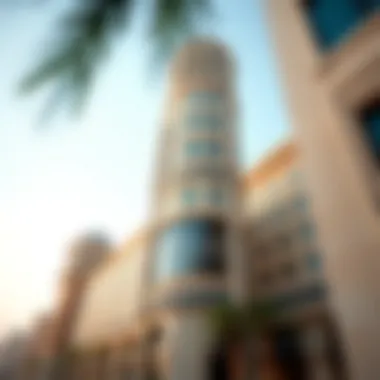

Stepping inside, the grandeur continues. The interior layout is thoughtfully designed to maximize space while ensuring comfort and functionality. Open-plan offices and collaborative spaces promote productivity and creativity, catering specifically to the needs of modern businesses. One can say it embodies the essence of contemporary work culture, where teamwork and innovation thrive.
Natural elements abound within the building, with indoor greenery featuring prominently. Plant walls add a refreshing touch, bringing a slice of nature into the urban environment. Every corridor and room is designed not just with aesthetics in mind but also to deliver an environment conducive to well-being. Such focus on the interior layout ensures that the Al Wasl Building isn’t just a place to work; it’s a space that enhances daily life, fostering relationships among its occupants.
Sustainable Design Practices
With the growing significance of sustainability in architecture, the Al Wasl Building incorporates several eco-friendly design practices that position it as a frontrunner in responsible construction. Solar panels adorn parts of the roof, harnessing renewable energy to power common spaces, which pulls down operating costs and minimizes the building’s carbon footprint.
Moreover, rainwater harvesting systems capture and repurpose water, feeding into irrigation systems for landscaping. This dual-purpose design not only showcases engineering ingenuity but also reminds us of the importance of conserving resources in today's world. As urban living continues to expand, buildings like the Al Wasl serve as vital examples of how design can intertwine with sustainability for future growth.
These unique design features demonstrate the Al Wasl Building's commitment not just to aesthetics but to functionality and sustainability in today’s ever-evolving urban landscape.
In summary, the design features of the Al Wasl Building encapsulate a harmonious blend of old and new, environmental consciousness, and innovative function. As we continue to observe the trajectory of architectural trends, this structure stands as a testament to Dubai's commitment to being at the forefront of modernity, enriching not only its skyline but its community as well.
For further insights into the Al Wasl Building and its design principles, consider exploring resources at Wikipedia or the relevant discussions on Reddit.
Cultural Impact of Al Wasl Building
The cultural significance of the Al Wasl Building reaches far beyond its architectural marvel. It plays an integral role in shaping the social fabric and cultural dialogue of Dubai. This striking structure, with its innovative design, serves not only as a visual landmark but also as a hub for communal interactions, artistic expression, and cultural activities. In this section, we will explore how Al Wasl Building influences local art and culture as well as its engagement with the community through events and activities.
Influence on Local Art and Culture
One of the standout features of Al Wasl Building is its ability to foster artistic endeavors. The structure stands as a beacon that attracts individuals from various creative fields. Some art installations and exhibitions are setup right within the building, showcasing local artists. The architecture itself often inspires these artists. For instance, the intricate patterns and designs in the facade often reflect traditional Islamic art, melding it with contemporary aesthetics.
Moreover, the building's openness encourages art from different backgrounds, creating a melting pot of styles and influences. Artists are motivated not just to display work but to interact with the audience and fellow creators. This kind of engagement helps revitalize and innovate the local art scene, drawing attention from not just residents but also tourists and art enthusiasts worldwide.
"In cities like Dubai, where growth and modernity thrive, it is crucial that cultural hubs like Al Wasl Building nurture the artistic community. This intertwining of architecture and art enhances the city's overall narrative."
Community Engagement and Events
Al Wasl Building doesn’t just serve as a structure; it actively participates in the cultural life of the community. Regular events often take place in the adjoining areas, designed to involve local residents and visitors alike. These can range from cultural festivals celebrating Emirati heritage to international artist showcases. Such events provide a platform for cultural exchange and foster a sense of belonging among attendees.
Key Aspects of Community Engagement:
- Cultural Festivals: These include performances, art performances, and culinary showcases that allow for interactive participation.
- Workshops and Seminars: Local artists and experts often conduct workshops within the building, encouraging hands-on involvement from the community.
- Exhibitions: Rotating exhibitions featuring new and emerging artists provide fresh content to engage visitors on a regular basis.
Through these community-based initiatives, the Al Wasl Building only strengthens its status as a cultural haven within Dubai. It draws people in and helps cultivate a shared cultural identity, thereby rooting itself firmly in the daily lives of those who pass through its doors.
This cultural impact is vital for real estate investors, homeowners, and renters alike. A building that serves as a cultural hub invariably enhances its locality, making neighborhoods more appealing. In today’s market, proximity to artistic and cultural venues becomes a critical aspect for buyers and tenants, intertwining lifestyle with living environment.
Economic Implications
The Al Wasl Building plays a pivotal role in the economic landscape of Dubai. Its sheer presence in the skyline not only reshapes the city's aesthetic but also influences various economic dimensions. As more businesses and individuals set their sights on Dubai, the factors surrounding other economic impacts, such as the real estate market and investment prospects, become increasingly significant. This section sheds light on the intricate connections between the Al Wasl Building and the broader economic framework of the city.
Real Estate Market Trends
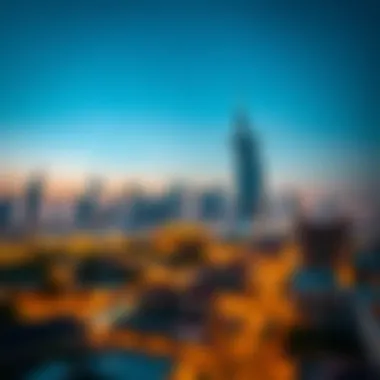

In recent years, Dubai's real estate market has witnessed a remarkable transformation, and the Al Wasl Building is part of this wave. Its iconic design and location have made it a centerpiece for luxury residential and commercial properties. Buyers and investors are keenly observing how such landmark buildings affect property values in nearby areas. The allure of the Al Wasl Building has led many real estate developers to incorporate similar architectural styles or themes in their projects.
Furthermore, properties in the vicinity have seen an uptick in demand. Buyers are often drawn to the idea of living or owning a business nearby a monumental site, especially one that symbolizes modernity and innovation. Residents and enterprises alike benefit from the prestige associated with such a landmark, often reflected in property prices.
Investors should note, however, that the bustling real estate scene can be fickle. As the demand spikes, pressure on housing and commercial spaces also increases, often leading to higher rental and sale prices. This dynamic creates a compelling but volatile market, where timing and strategy are essential for potential investors.
"Dubai’s skyline is a testament to its ambition. The Al Wasl Building stands not just as a structure but as an investment magnet that reshapes market patterns."
Investment Opportunities
The Al Wasl Building opens various avenues for potential investors, both local and international. The surrounding region is evolving into a hotspot for investment due to its strategic location and modern infrastructure. This opportunity comes with several layers, inviting a wide array of investment types.
- Commercial Ventures: The rise in foot traffic around the Al Wasl Building signals a promising environment for retail and hospitality businesses. Establishments that set up shop here benefitting from high visibility, attracting both tourists and locals.
- Residential Properties: Interest in living near such a landmark continues to rise. Developers are diving into projects that offer luxurious amenities to cater to this demand.
- Event Spaces: Given the building's capacity for hosting various events and exhibitions, investing in facilities that provide services tailored for corporate functions or cultural gatherings could be lucrative.
Investors should conduct thorough due diligence, monitoring real estate trends and the economic pulse of Dubai. Partnering with reputable local agencies can provide insights and foster good relationships within the community, leading to fruitful collaborations in future ventures.
Challenges in Development
The Al Wasl Building stands as a testament to modernity, yet like any ambitious project, it faced a myriad of challenges during its development process. Understanding these obstacles not only underscores the complexity of constructing such landmark structures but also highlights the resilience and innovation required to overcome them. Here, we will explore two significant types of hurdles: construction difficulties and regulatory hurdles.
Construction Difficulties
With groundbreaking architectural visions comes the weight of practical construction difficulties. From the get-go, the Al Wasl Building was not just another structure; it was a bold ambition that sought to redefine Dubai's skyline. This ambition translated into several construction challenges:
- Material Selection: Sourcing the right materials suitable for the unique design posed a logistical headache. The building incorporates advanced materials, which required careful consideration to ensure they met both aesthetic and functional needs. For instance, using glass that could withstand Dubai’s extreme heat while maintaining clarity added layers to the decision-making process.
- Structural Integrity: The unconventional shapes and heights demanded innovative engineering solutions. The architectural team had to ensure the design’s integrity while accommodating the unique wind patterns typical of the area. Without a solid foundation and structural framework, the stunning design could become a mere fantasy.
- Weather Conditions: Construction in Dubai is often hindered by high temperatures and sand storms. Such environmental factors pushed teams to adjust work hours and implement additional safety measures. For instance, some aspects of construction had to be timed carefully around the weather, affecting project schedules and budgets.
"The construction process of the Al Wasl Building was akin to piecing together a puzzle, where every piece had to fit perfectly to create a stunning work of art."
These construction difficulties not only challenged the builders but also forced a reevaluation of approaches, leading to innovations that may well influence future projects.
Regulatory Hurdles
In addition to physical construction challenges, the Al Wasl Building navigated a labyrinth of regulatory hurdles that are often part and parcel of sizable developments in Dubai. Each step required adherence to intricate laws and local regulations, which come with their own set of considerations:
- Permit Approvals: Obtaining the necessary permits for such a monumental project can be a lengthy process. Each application had to align with Dubai's stringent building codes and urban planning requirements. The approval process involved numerous stakeholders, including city planners and environmental agencies.
- Zoning Laws: The Al Wasl Building's concept had to comply with existing zoning laws, which dictate how spaces can be utilized. Changes in zoning policies could delay progress if not managed carefully. The planners needed to ensure that the building aligned with broader city development strategies while respecting neighboring communities.
- Cultural Considerations: Given Dubai’s diverse demographics, the building also needed to reflect cultural sensitivities and architectural styles that resonate with the public. Navigating these social and cultural parameters can often be more challenging than aligning with regulatory frameworks.
Overcoming these regulatory hurdles not only shaped the development process but also instilled a collective understanding of how to collaborate with authorities and community leaders.
In summary, the Al Wasl Building's journey through construction difficulties and regulatory hurdles showcases the grit and creativity embedded in modern architecture. It has paved the way for future endeavors that aspire to leave an indelible mark on the urban landscape.
Comparative Analysis
Comparative analysis serves as a vital element in understanding the Al Wasl Building's significance within Dubai's ever-evolving skyline. It provides distinct insights by measuring its characteristics against well-known landmarks both locally and globally. By doing so, we can appreciate not just the uniqueness of the Al Wasl Building but also how it fits into the broader narrative of architectural innovation and urban development. This examination ultimately benefits real estate investors, buyers, and renters by highlighting trends and characteristics worth noting in their quests.
Al Wasl Building and Other Landmarks
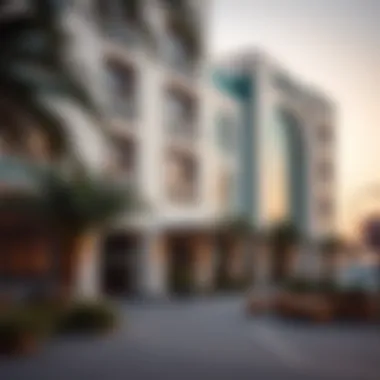

When looking at the Al Wasl Building alongside other notable structures in Dubai, like the Burj Khalifa or the Dubai Mall, several interesting contrasts emerge. For instance, while the Burj Khalifa reaches incredible heights and is famed for its modernist style, the Al Wasl Building offers a different narrative through its unique design inspired by traditional Arab architecture. This harmonious blend reflects not merely a building but a cultural statement.
Some key points of comparison include:
- Height and Structure: The Burj Khalifa is a skyscraper reaching dizzying heights, while Al Wasl Building focuses more on horizontal space and decorative elements. This difference in scale impacts the visual landscape significantly.
- Design Philosophy: While many modern buildings prioritize functionality, Al Wasl harmonizes art and purpose. The distinct circular atrium is a standout feature, offering both aesthetic value and function.
- Cultural Resonance: The design of Al Wasl encapsulates Islamic art and architecture, making it a symbol of national identity. This is a contrast to other buildings that, while iconic, may not reinforce local culture to the same extent.
Lessons from Global Architectural Trends
When assessing the Al Wasl Building, one can draw lessons from architectural trends worldwide. As cities become denser, architects globally are leaning towards sustainable practices, which are deftly incorporated into Al Wasl’s design philosophy. Emphasis on eco-friendly elements not only supports environmental objectives but can also enhance property value—a crucial factor for real estate stakeholders.
Some trends that resonate include:
- Green Spaces: Reflecting a global shift toward integrating nature within urban settings, the Al Wasl Building incorporates lush garden spaces, promoting biodiversity and well-being among residents and visitors.
- Community-Centric Designs: The push for buildings that serve beyond their intended purposes aligns with global movements advocating for community engagement within architectural planning. Al Wasl’s emphasis on public accessibility and event hosting is a clear nod to this trend.
- Technological Integration: In an increasingly digital world, smart technology finds its way into modern architecture. The incorporation of advanced materials and smart building designs is mirrored in Al Wasl, aiming to enhance the overall experience.
By looking at the Al Wasl Building through these comparative lenses, we can uncover not just its individual merit but also its relevance in the larger conversation about architecture's role in urban growth and cultural representation.
Future Perspectives
The future of the Al Wasl Building goes beyond its architectural marvel and stands as a crucial piece in the broader puzzle of Dubai's urban landscape. This section delves into projected advancements and its expected role in urban planning, highlighting the importance of understanding how such landmarks can impact various facets of urban development.
Projected Developments
Looking forward, one can imagine the Al Wasl Building evolving in tandem with Dubai's ambitions. As a hub of commerce and tourism, there are whispers of upcoming facilities that may be added to enhance its value. Plans for integrated parks, retail spaces, and cultural centers could be on the horizon, offering visitors and locals alike an enriching experience. The goal? To transform this landmark from just a stunning visual element into a multifunctional ecosystem that fosters community ties.
There's talk about how the building might embrace smart technology. Imagine walking into a lobby where the lights adjust based on natural light levels or interactive screens provide information about upcoming events. Technologies like these could elevate the visitor experience and position the Al Wasl Building as a front-runner in futuristic urban experiences.
Role in Urban Planning
The impact of the Al Wasl Building in urban planning cannot be overstated. As urban density continues to increase, such landmarks serve as anchors for development. They influence zoning laws, transportation routes, and the general aesthetic of surrounding areas. Increased public transport accessibility around this landmark is a prime example of how its presence can drive infrastructural change.
Furthermore, the building's design and operational efficiencies can inspire upcoming projects. By establishing energy-efficient practices or offering new models for public engagement, the Al Wasl Building may prompt neighboring structures to adopt similar features, resulting in a city that's not just about skyscrapers but about sustainable growth and active community participation.
"The embrace of innovative urban concepts within landmark developments like the Al Wasl Building represents a significant stride towards holistic urban ecology."
In a nutshell, as the Al Wasl Building charts its course into the future, its role will likely transcend the mere visual—it will become a cornerstone in shaping not just the skyline, but the very essence of urban life in Dubai.
Culmination
The conclusion serves as a crucial component in encapsulating the essence of the Al Wasl Building and its multifaceted influence within the Dubai urban landscape. It brings together various threads of discussion, weaving them into a coherent narrative that allows readers to appreciate both the building’s architectural significance and its broader implications in real estate and community dynamics.
Summation of Key Points
In summary, a few key aspects stand out:
- Architectural Innovation: The building is not just a structure—it's a statement of modern design and sustainability, pushing the boundaries of conventional architecture.
- Cultural Hub: Al Wasl Building plays a pivotal role as a cultural centerpiece, fostering arts and community engagement, thereby enriching the local social fabric.
- Economic Driver: By influencing real estate trends, it attracts investments and boosts the economy, positioning Dubai as a prime location for property investors.
- Future-Oriented: Perspectives on urban planning surrounding the building indicate a forward-thinking approach, promoting smart city advancements and sustainable living.
Final Thoughts on Al Wasl Building
As we wrap up our examination, it becomes evident that the Al Wasl Building is more than an impressive sight on Dubai's skyline. It’s a symbol of progress, representing not only the architectural prowess but also the spirit of a city that thrives on innovation and cultural vibrancy. For investors, buyers, and renters, understanding this landmark's role within the larger context of Dubai’s economic and cultural landscape is essential.
The Al Wasl Building thus epitomizes the intersection of modern architecture with community and economic development, making it a focal point for discerning audiences eager to tap into the opportunities Dubai presents. Whether you are looking to invest or merely pondering the depth of urban architecture, this remarkable structure invites deeper contemplation about the future of our cities.

